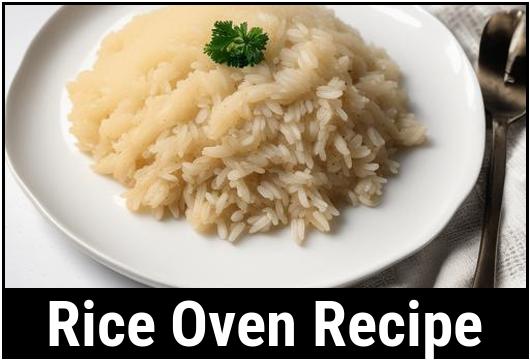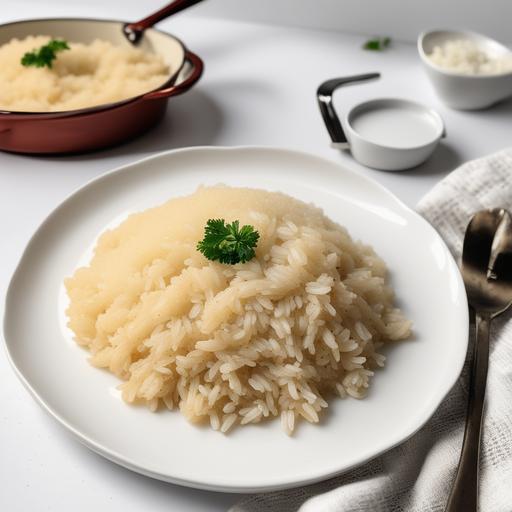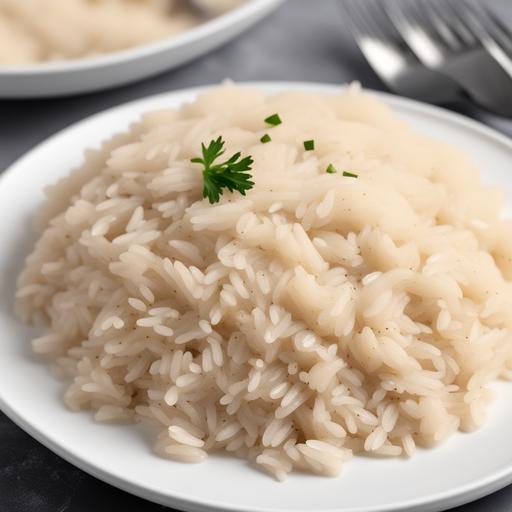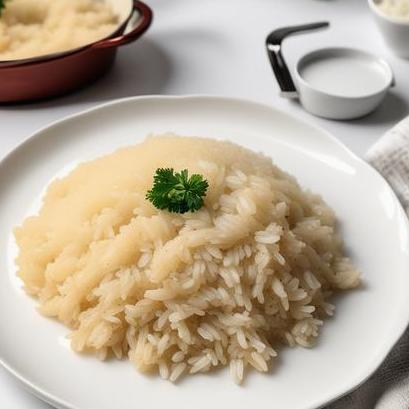
The Ultimate Guide To Cooking Rice In An Oven
Rice is a staple food for billions of people worldwide, appreciated for its versatility, nutritional value, and comforting taste. While cooking rice on the stovetop is the most common method, there are alternative approaches that can yield equally delicious results. One such method is cooking rice in an oven. This technique offers convenience and consistency, producing perfectly cooked rice without the need for constant monitoring.
In this comprehensive guide, we’ll delve into the food science behind cooking rice in an oven, discuss the selection of ingredients, detail the preparation process, determine the optimal oven temperature and timing, and provide a step-by-step recipe for preparing rice in an oven. Whether you’re a seasoned home cook or a novice in the kitchen, this article will equip you with the knowledge and skills to master the art of oven-baked rice.
Food Science Of Cooking Rice In An Oven
Cooking rice in an oven involves a slightly different approach compared to traditional stovetop methods. The oven’s radiant heat gently cooks the rice, allowing for even distribution of temperature throughout the cooking vessel. This consistent heat helps ensure uniform cooking and prevents unevenly cooked grains, which can occur when using a stovetop.
Additionally, cooking rice in an oven allows for greater control over the cooking environment. By adjusting the oven temperature and cooking time, you can tailor the cooking process to achieve your desired rice texture, whether you prefer fluffy and separate grains or a more creamy consistency.
Furthermore, the oven’s enclosed space helps retain moisture during the cooking process, resulting in rice that is tender and moist. This can be particularly beneficial when cooking certain types of rice, such as long-grain varieties, which have a tendency to dry out when cooked using traditional methods.
Choosing Ingredients
The key to making delicious oven-baked rice lies in selecting the right ingredients. Here are some considerations when choosing your ingredients:
Rice
Choose a variety of rice that is well-suited for oven cooking. Long-grain varieties such as basmati or jasmine rice work particularly well, as they tend to remain fluffy and separate when cooked. However, you can also use medium-grain or short-grain rice depending on your preference.
Liquid
The liquid you use to cook the rice is crucial for achieving the desired texture and flavor. Water is the most common choice, but you can also use broth or coconut milk for added richness and flavor. Ensure that the ratio of liquid to rice is appropriate for the type of rice you’re using and the desired final consistency.
Seasonings
Seasonings such as salt, herbs, spices, and aromatics can enhance the flavor of the rice. Consider adding ingredients like garlic, onion, bay leaves, or turmeric to infuse the rice with depth and complexity.
Preparing Ingredients

Before you begin cooking, it’s essential to properly prepare your ingredients. Follow these steps for optimal results:
Rinse The Rice
Rinsing the rice under cold water helps remove excess starch, resulting in grains that are less sticky when cooked. Place the rice in a fine-mesh sieve or colander and rinse it thoroughly until the water runs clear.
Measure The Liquid
Carefully measure the liquid according to the recipe or package instructions. Using the correct ratio of liquid to rice is crucial for achieving the desired texture and consistency.
Seasonings
Prepare any additional seasonings or aromatics you plan to use in the recipe. Chop herbs, mince garlic, or dice onions as needed, ensuring that they are evenly distributed throughout the rice.
Optimal Oven Cooking Temperature & Timing
To achieve perfectly cooked rice in the oven, it’s essential to set the oven to the correct temperature and monitor the cooking time closely. Here are some guidelines to follow:
Oven Temperature
Preheat the oven to 350°F (175°C) for most rice recipes. This moderate temperature ensures even cooking without risk of burning or drying out the rice.
Cooking Time
The cooking time can vary depending on the type of rice and the desired texture. In general, most rice varieties will require around 20-30 minutes of cooking time in the oven. However, it’s essential to check the rice periodically and adjust the cooking time as needed to prevent overcooking.
Resting Time
After the rice has finished cooking, allow it to rest for a few minutes before fluffing with a fork. This resting period allows the rice to finish steaming and helps ensure a light and fluffy texture.
Rice Oven Recipe
Now that you’re familiar with the science and preparation of oven-baked rice, let’s dive into a step-by-step recipe:
Ingredients
- 1 cup long-grain rice
- 1 ¾ cups water or broth
- 1 tablespoon olive oil or butter
- Salt to taste
- Optional: minced garlic, diced onion, chopped herbs
Instructions
- Preheat the oven to 350°F (175°C).
- Rinse the rice under cold water until the water runs clear.
- In a Dutch oven or oven-safe dish, combine the rinsed rice, water or broth, olive oil or butter, and salt.
- Add any optional seasonings or aromatics, such as minced garlic or diced onion, if desired.
- Cover the dish tightly with a lid or aluminum foil.
- Place the dish in the preheated oven and bake for 20-25 minutes, or until the rice is tender and the liquid has been absorbed.
- Remove the dish from the oven and let it sit, covered, for 5 minutes.
- Fluff the rice with a fork before serving.
Cooking rice in an oven is a simple yet effective method that yields consistently delicious results. By understanding the science behind oven-baked rice, carefully selecting ingredients, and following a few key steps, you can create fluffy, perfectly cooked rice every time. Whether you enjoy it as a side dish, a base for stir-fries, or as part of a comforting meal, oven-baked rice is sure to become a staple in your culinary repertoire. Experiment with different varieties of rice, seasonings, and cooking techniques to customize your rice dishes to suit your taste preferences. With practice and patience, you’ll master the art of oven-baked rice and impress your family and friends with your culinary skills.
Doneness Checks

Cooking rice in the oven is a straightforward method that requires minimal hands-on time, making it an excellent option for busy home cooks or those looking for an easy way to prepare a side dish. Unlike stovetop cooking, which requires constant monitoring and stirring, oven-baked rice allows you to set it and forget it, freeing up your time to focus on other tasks.
The basic premise of oven-baked rice involves combining rice, liquid, and seasonings in an oven-safe dish, then baking it at a specific temperature for a set amount of time. This method ensures even cooking and fluffy, tender grains without the risk of burning or sticking to the bottom of the pot.
Determining when your oven-baked rice is done is crucial to achieving the perfect texture and flavor. Here are some methods for checking doneness:
1. Visual Inspection
One of the simplest ways to check if your rice is done is by visually inspecting it. When fully cooked, the grains should be plump and tender, with all the liquid absorbed. Use a fork to fluff the rice gently, and ensure there are no clumps or pockets of uncooked grains.
2. Texture Test
To determine if the rice is cooked to your liking, take a small spoonful and taste it. The grains should be soft but not mushy, with a slight chewiness to them. If the rice is still crunchy or firm in the center, it needs more time in the oven.
3. Temperature Check
Using a food thermometer, insert it into the center of the rice dish to measure the internal temperature. Fully cooked rice should register at least 200°F (93°C). If the temperature is lower, continue baking until it reaches the desired level.
4. Time Calculation
Following the recommended cooking time in the recipe is a good starting point, but every oven is different, so it’s essential to monitor the rice closely towards the end of the baking time. Adjust the cooking time as needed based on your oven’s performance and the desired doneness of the rice.
Undercooking
Undercooked rice can be disappointing, with crunchy or firm grains that lack the desired tenderness. Here are some common reasons why rice may be undercooked when baked in the oven:
1. Inadequate Liquid
Insufficient liquid can prevent the rice from fully absorbing moisture during baking, resulting in undercooked grains. Ensure that you use the correct ratio of liquid to rice as specified in the recipe and avoid reducing the amount of liquid unless you’re familiar with how it will affect the final outcome.
2. Improper Temperature
Baking rice at too low of a temperature can prolong the cooking time and lead to undercooked results. Ensure that your oven is preheated to the correct temperature as indicated in the recipe and avoid opening the oven door frequently, as this can cause fluctuations in temperature and affect the cooking process.
3. Incorrect Rice Type
Different varieties of rice require different cooking times and liquid ratios. Using the wrong type of rice or substituting one variety for another without adjusting the recipe accordingly can result in undercooked or overcooked grains. Stick to the type of rice specified in the recipe for the best results.
4. Inadequate Resting Time
Allowing the rice to rest after baking is essential for ensuring that it reaches its optimal texture. During this resting period, residual heat continues to cook the rice, and the grains absorb any remaining moisture, resulting in a fluffy and tender consistency. Avoid skipping this step, as it can lead to undercooked rice.
Overcooking
Overcooked rice can be mushy, gummy, or even burnt, detracting from its flavor and texture. Here are some common reasons why rice may be overcooked when baked in the oven:
1. Excessive Liquid
Using too much liquid in the recipe can lead to overcooked rice, as the grains become saturated and lose their individual texture. Stick to the recommended ratio of liquid to rice and avoid adding extra water or broth unless necessary.
2. Extended Cooking Time
Leaving the rice in the oven for longer than the recommended cooking time can result in overcooked grains. It’s essential to monitor the rice closely towards the end of the baking time and remove it from the oven as soon as it reaches the desired doneness.
3. High Oven Temperature
Baking rice at too high of a temperature can cause it to cook too quickly on the outside while remaining undercooked on the inside. Ensure that your oven is set to the correct temperature as specified in the recipe and avoid using the broil setting, which can result in uneven cooking.
4. Improper Covering
Covering the rice dish too tightly or using the wrong type of lid can trap steam and moisture, causing the rice to become mushy. Use a lid or foil to cover the dish loosely, allowing some steam to escape during baking.
Troubleshooting

Encountering issues while baking rice in the oven is not uncommon, but with a few adjustments, you can salvage your dish and achieve delicious results. Here are some troubleshooting tips for common problems:
1. Dry Or Undercooked Rice
If your rice is dry or undercooked, try adding a small amount of additional liquid, such as water or broth, and returning it to the oven for further cooking. Cover the dish tightly with foil to prevent moisture from escaping, and bake until the rice is tender and fully cooked.
2. Sticky Or Mushy Rice
To fix sticky or mushy rice, transfer it to a large baking sheet and spread it out in an even layer. Place the sheet in the oven and bake at a low temperature (around 300°F or 150°C) for 10-15 minutes, or until the excess moisture evaporates, and the grains separate. Fluff the rice with a fork before serving.
3. Burnt Rice On The Bottom
If the bottom layer of rice is burnt, carefully scrape off the burnt portion with a spoon, being careful not to disturb the rest of the rice. Transfer the remaining rice to a clean dish, cover it with foil, and continue baking until fully cooked. Reduce the oven temperature slightly to prevent further burning.
4. Uneven Cooking
If some parts of the rice are cooked while others remain undercooked, gently stir the rice to redistribute the grains, ensuring that they are evenly distributed in the dish. Cover the dish tightly with foil and return it to the oven for further cooking until all the grains are tender.
Recipe Variations
Oven-baked rice is incredibly versatile and can be customized with various seasonings, ingredients, and cooking methods to suit your taste preferences. Here are some exciting recipe variations to try:
1. Spanish Rice
Add diced tomatoes, bell peppers, onions, and garlic to the rice mixture for a flavorful Spanish-inspired dish. Sprinkle with paprika, cumin, and chili powder for an extra kick of flavor.
2. Coconut Rice
Replace some of the water with coconut milk for a creamy and aromatic coconut rice. Add shredded coconut and a pinch of sugar for added sweetness, and garnish with chopped cilantro before serving.
3. Mushroom Risotto
Combine Arborio rice with chicken or vegetable broth, sautéed mushrooms, onions, and garlic for a decadent mushroom risotto. Stir in Parmesan cheese and butter for a creamy finish, and bake until the rice is tender and creamy.
4. Lemon Herb Rice
Infuse the rice with fresh lemon zest, chopped herbs such as parsley, thyme, and rosemary, and a drizzle of olive oil for a bright and flavorful side dish. Serve with grilled chicken or fish for a light and refreshing meal.
Cooking rice in the oven is a simple and convenient method that yields delicious results with minimal effort. By following the tips and techniques outlined in this guide, you can achieve perfectly cooked rice every time, whether you prefer fluffy grains or creamy risotto. Experiment with different seasonings, ingredients, and recipe variations to create unique and flavorful dishes that will impress family and friends alike. With a little practice and creativity, oven-baked rice can become a staple in your culinary repertoire, adding versatility and convenience to your home cooking routine.
Flavour Enhancement Tips
Cooking rice in the oven may seem unconventional to some, but it’s a technique that yields excellent results with minimal effort. By utilizing the even heat distribution of an oven, you can achieve perfectly cooked rice with fluffy grains and enhanced flavor. This method is particularly useful when preparing large quantities of rice or when you want to free up space on your stovetop for other dishes.
One of the advantages of cooking rice in the oven is the opportunity to infuse it with additional flavors. Here are some tips to enhance the taste of your oven-baked rice:
1. Aromatic Additions
Incorporate aromatic ingredients such as garlic, onions, ginger, or spices like cumin, coriander, or cinnamon to infuse the rice with rich flavors. Sauté these aromatics in oil before adding them to the rice for a more pronounced taste.
2. Broth Or Stock
Replace water with broth or stock to add depth and complexity to the rice. Vegetable, chicken, or beef broth can elevate the flavor profile of your dish significantly. Ensure the broth is well-seasoned for best results.
3. Herbs And Citrus Zest
Fresh herbs like parsley, cilantro, or thyme can impart freshness to the rice, while citrus zest adds brightness and zing. Simply sprinkle chopped herbs or grated citrus zest over the rice before baking for a burst of flavor.
4. Coconut Milk
For a tropical twist, substitute some of the water with coconut milk. This will impart a creamy texture and subtle sweetness to the rice, perfect for pairing with Asian or Caribbean-inspired dishes.
Texture Enhancement Tips

Achieving the perfect texture is key to a successful rice dish. With oven baking, you can control the moisture levels more precisely, resulting in rice that’s neither too mushy nor too dry. Here’s how to optimize the texture of your oven-baked rice:
1. Proper Water Ratio
Maintaining the correct water-to-rice ratio is crucial for achieving the desired texture. As a general rule, use 1.5 to 2 cups of water or broth for every cup of rice, depending on the variety of rice and your preferred consistency.
2. Covered Baking
Cover the baking dish tightly with aluminum foil or a lid to trap steam and prevent moisture loss. This will help the rice cook evenly and retain its moisture, resulting in tender grains.
3. Resting Time
Allow the rice to rest for a few minutes after baking to allow any excess moisture to redistribute evenly. Fluff the rice gently with a fork to separate the grains and release steam, which can further improve the texture.
4. Toasting Before Baking
To enhance the nutty flavor and chewy texture of certain rice varieties like basmati or jasmine, consider toasting them in a dry skillet before adding them to the baking dish. This extra step adds depth to the final dish.
Cooking At Different Temperatures
The temperature at which you bake your rice can influence its texture and flavor. Here’s how to adjust the oven temperature for optimal results:
1. Low And Slow (300°F / 150°C)
Baking rice at a lower temperature for a longer duration can result in perfectly cooked grains with a slightly chewy texture. This method is ideal for brown rice or wild rice, which require a longer cooking time to soften.
2. Moderate Heat (350°F / 175°C)
This is the standard temperature for baking most types of rice, including white rice and long-grain varieties. It ensures even cooking and fluffiness without drying out the grains.
3. High Heat (400°F / 200°C)
Baking rice at a higher temperature can yield a slightly crispy texture around the edges, which some people find appealing. It’s a great option for dishes where a bit of crunch adds dimension, such as rice casseroles or pilafs.
Cooking Tips
Mastering the art of oven-baked rice requires attention to detail and some handy techniques. Here are some additional tips to ensure success:
1. Use The Right Pan
Choose a baking dish with a tight-fitting lid or cover it securely with aluminum foil to prevent steam from escaping during cooking. A shallow dish will promote even heat distribution and quicker cooking.
2. Don’t Overcrowd The Pan
Spread the rice evenly in the baking dish to ensure that each grain cooks uniformly. Overcrowding can lead to uneven cooking and soggy patches.
3. Check For Doneness
Rice is done when all the liquid has been absorbed, and the grains are tender but still separate. Use a fork to fluff the rice and check for any remaining moisture. If necessary, return it to the oven for a few more minutes.
4. Experiment With Flavors
Don’t be afraid to get creative with your rice dishes. Experiment with different herbs, spices, and mix-ins to create unique flavor combinations that suit your taste preferences.
Serving Suggestions
Oven-baked rice is a versatile side dish that pairs well with a wide range of main courses. Here are some serving suggestions to inspire your next meal:
1. Asian-Inspired Stir-Fry
Serve oven-baked rice alongside your favorite stir-fry for a quick and satisfying meal. The fluffy texture of the rice pairs perfectly with saucy stir-fried vegetables and protein.
2. Mediterranean Feast
Pair oven-baked rice with grilled meats, roasted vegetables, and a selection of dips and sauces for a Mediterranean-inspired feast. The nutty flavor of the rice complements the bold flavors of the region beautifully.
3. Tex-Mex Delight
Use oven-baked rice as a base for Tex-Mex-inspired dishes like burrito bowls or enchiladas. Top the rice with seasoned beans, grilled chicken or beef, avocado, salsa, and a dollop of sour cream for a hearty and flavorful meal.
Conclusion
Cooking rice in the oven offers a convenient and foolproof method for achieving perfect results every time. By following the flavor enhancement tips, texture optimization methods, and cooking tips outlined in this guide, you can elevate your rice dishes to new heights of deliciousness. Whether you’re serving it as a side dish or incorporating it into a main course, oven-baked rice is sure to delight your taste buds and impress your guests. Experiment with different flavors and serving suggestions to discover your favorite combinations, and enjoy the culinary journey!
FAQS
What Is A Rice Oven Recipe?
A rice oven recipe is a method of cooking rice using an oven instead of a stovetop. It involves baking rice in a covered dish to achieve a fluffy and evenly cooked texture.
How Do I Choose The Right Type Of Rice For A Rice Oven Recipe?
When selecting rice for a rice oven recipe, it is essential to choose a variety that has a long grain and a low starch content. Basmati rice or jasmine rice are often recommended for their aromatic flavors and ability to absorb liquids without becoming mushy. Alternatively, you can also opt for long-grain white rice or brown rice, depending on your preferences.
What Ingredients Are Typically Used In A Rice Oven Recipe?
The ingredients commonly used in a rice oven recipe include rice, water or broth, butter or oil, and salt. However, you can add additional ingredients such as vegetables, spices, herbs, or even protein like chicken or shrimp to enhance the flavor and make it a complete meal.
How Do I Prepare The Rice For A Rice Oven Recipe?
To prepare the rice for a rice oven recipe, start by rinsing the rice under cold water to remove any excess starch. Then, drain the rice thoroughly. In a separate pot, bring the desired amount of water or broth to a boil. Add the rice, reduce the heat, cover the pot, and let it simmer for a few minutes. After the initial stovetop preparation, transfer the partially cooked rice to an oven-safe dish for further cooking in the oven.
What Is The Cooking Process For A Rice Oven Recipe?
The cooking process for a rice oven recipe typically involves preheating the oven to a specific temperature (such as 350°F or 180°C), while ensuring the oven rack is placed in the middle position. Once the oven is preheated, transfer the partially cooked rice to an oven-safe dish and add the remaining ingredients according to the recipe instructions. Cover the dish tightly with foil or a lid to prevent steam from escaping. Place the dish in the oven and bake it for a specified time, usually around 20-30 minutes or until the rice is tender and all the liquid has been absorbed. Remember to let the rice stand for a few minutes before fluffing it with a fork and serving.


